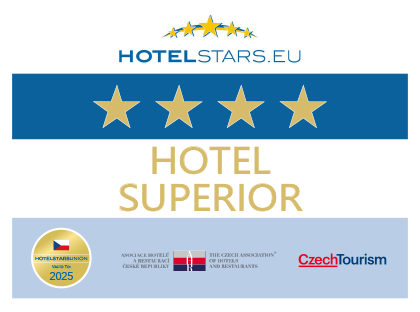CHATEAU DE FRONTIERE
Hraniční zámeček
CHATEAU DE FRONTIERE / Border Chateau is a classicist structure built by the Liechtenstein family between 1816 and 1827. It was built by Jan I. Josef of Liechtenstein for the purpose of relaxation and rest and served as the summer residence for the noble family. The name of the chateau and the inscription on the facade of the building, "Zwischen Österreich und Mähren", reminds us that the land on which the castle was built originally belonged to Moravia, but around the time of construction, the border between Margraviate of Moravia and Archduchy Lower Austria met in the centre of the castle. This borderline is signified by a stream which flows from the vase of the laying nymph statue. The original project of the castle was designed as two castles, but Prince Jan did not like the idea because he already had a castle, “Janův hrad”, and it would not even fit into the countryside of the temples around the Lednice´s ponds. Thus the project was redesigned to its present image. Due to the location of the construction on a marshy ground, before the foundation stone was laid, costly and time-consuming reinforcements, in the form of massive grids and countless wooden pilots hammered into the ground, had to be done. The building itself consists of a ground-floor building with three pavilions which are connected by blind-wall terraces with Tuscan columns. The largest, middle pavilion is highlighted by a three-poster loggia, the outter pavilions are decorated with large French windows and a pair of embedded Tuscan columns. As well as the exterior, great care was also devoted to the interior of the chateau, which was elegantly and very modernly equipped at that time. Between the years 1936 and 1937 of the first republic tense atmosphere, when it was being decided to build a defence system of our borders, the Border Chateau was included in this strategy and a military bunker was built into its walls. After the chateau was confiscated in 1945, it was used as an ornithological station and significant rebuilding did not happen until the post-revolutionary years.
The beginnings of the Liechtenstein aristocratic family can be traced back to Bavaria in the 11th century, from where they originated in Lower Austria. The Moravian-Austrian branch of the family was founded in the 13th century by Jindřich I., who was a leading supporter of the Czech King Přemysl Otakar II. In 1249, he received the castle and Mikulov village for his faithful service. Mikulov Castle was the first Liechtenstein estate/manor in Moravia. Thanks to services provided to Czech kings, wealthy operations/manoeuvres and marriages, Liechtenstein´s territorial conditions were expanded to many other important mansions/manorssu, including Lednice and their headquarters Valtice. Liechtensteins ranks amongst the most powerful families in Moravia, held high in leading provincial authorities, they expanded their influence and wealth. For over eight centuries, they have shaped and built the face of the landscape, which is one of the pearls of the treasury in the historic and cultural wealth of the Czech Republic and Austria. In accordance with their sophisticated understanding of the role of the owner of large plots of land, the Valtice and Lednice chateaux exhibition were built with adjoining gardens and buildings which accentuate the naturally molded landscape. To achieve this, a design office was set up in Lednice where radical projects for the redevelopment of older buildings, as well as new construction projects are created and have filled the Lednice-Valtice lndscape since the 18th century onwards.
Little Border Chateau got its name from the border between the Moravian Margraviate and Lower Austria which crosscut it. On the facade there is still a German inscription: “Between Austria and Moravia”. The land was annexed to the Czechoslovak Republic in 1919, which destroyed the building´s particularity, however it did not touch its charm.A two-storey building with three pavilions and garden houses features illusive paintings of architecture. It is embedded among high trees and dark blue waters of the pond with an extraordinary sense of taste. The tourists tired of walking around Lednice-Valtic Cultural Landscape are attracted (besides the great architectonical and historical value) by the opportunity to have an excellent dish or drink, or take the advantage of accommodation situated in the quiet nature near the city of Lednice and whole Lednice-Valtice Cultural Landscape.
Being completely renovated in 1995-1996 by Jan Kašník, a native of Hlohovec, the building serves as a restaurant and an all-year hotel. The guests may enjoy the restaurant, coffee room, lounges and summer terrace not only for an occasional rest but also for different social events (business meetings, weddings, graduation and christening parties, family celebrations, exhibitions, company presentations, seminars etc.). A disabled friendly hotel was erected as a part of Little Border Chateau to provide the customers with the most comprehensive services.


Social networks
Hotel surroundings
- TripAdvisor:
- Restaurant ESSENS
- Hotel Chateau de Frontiere
- Chateau Petit
- They wrote about us:
- Forbes
- Millenium
ADDRESS
HZ Hotel s.r.o.
IČ: 06167276
Zaoralova 3045/1e, 628 00 Brno
Provozovna:
K Zámečku 16, 691 43
Hlohovec u Břeclavi
Contact
Reception:
+420 731 401 456
+420 519 354 354
Restaurant ESSENS:
+420 730 575 555
Chateau Petit:
+420 602 728 292
GPS: 48°46'49.746"N, 16°45'28.063"E
© CHATEAU DE FRONTIERE 2017-










